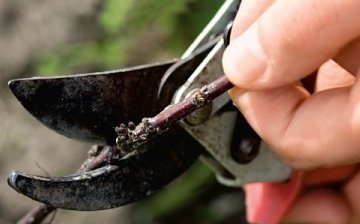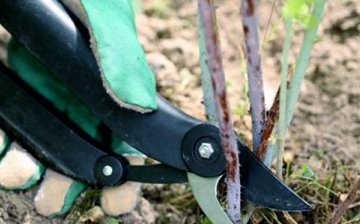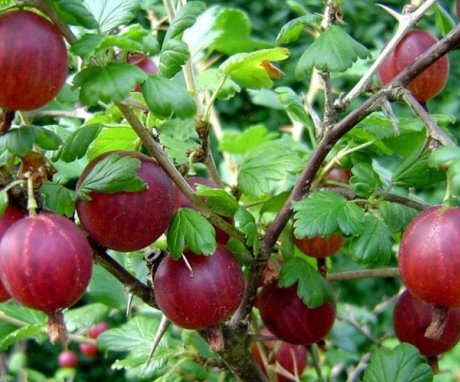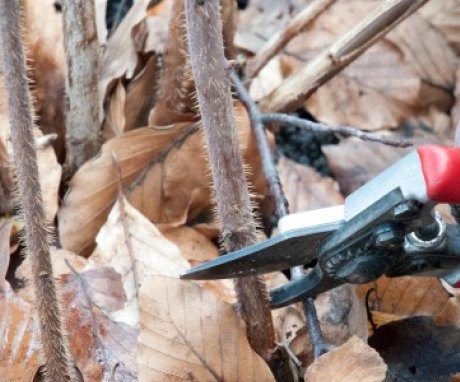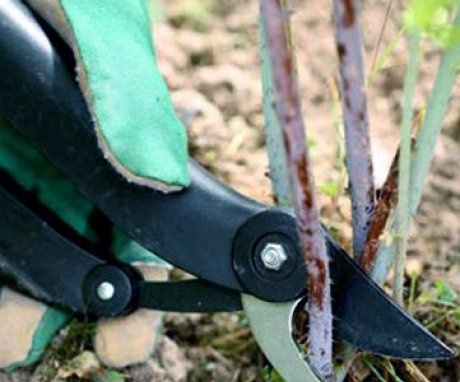Pruning gooseberries in the fall - tips and rules for forming a bush
Gooseberry is a fairly common type of shrub that grows in gardens and summer cottages. The pleasant taste of its berries does not leave indifferent even the most sophisticated gourmet. Vitamin gooseberries are good for jam and for freezing. In general, sheer benefit! It's autumn outside and it's time to think about pruning shrubs for winter. We will discuss how to do this correctly in this article.
Content:
Why do gooseberry pruning?
Many people know that gooseberries predominantly prefer areas with good lighting for their active growth. In other words, gooseberry loves light, as it belongs to light-loving cultures. Due to this, the plant undergoes an active process of photosynthesis during the summer, as a result of which its growth processes are activated. Therefore, during the warm season, quite a lot of young green shoots are formed in it. At the same time, it becomes difficult to get to its berries due to the thickening of the bush. This, in turn, directly affects the quantity and quality. harvest... To avoid this, it is necessary to prune in the autumn season.
Features of gooseberry pruning during the autumn period:
- It is advisable to do pruning every year in the fall, as the next year the young shoots will reappear. In this case, the gooseberry will acquire a neat appearance and the harvest will become much safer.
- By pruning gooseberry bushes in the fall, you not only contribute to the penetration of sunlight necessary for growth to the lower bushes, but also directly affect the process of it formation... Therefore, you should not be lazy with the onset of the "golden" season, but do something useful for the growth of a wonderful shrub. The pruned bush looks much prettier against the backdrop of wilting nature, compared to its overgrown brother.
- Another advantage of pruning in the fall is that there is a minimal risk of infection of the bushes with fungal organisms, of which there are so many on old bushes. Spring renewal of bushes not yet infected with fungal diseases, will contribute to the formation of a healthy berry harvest.
- Annual pruning of old bushes will contribute to the formation of larger berries on young shoots, which are much more pleasant to pick. In addition, larger berries have a much nicer taste.
Typically, gooseberry bushes can be about one or one and a half meters high. The defining value in this case is the characteristics of the variety that you are growing. On average, one gooseberry bush has about twenty-five branches. The greater value of the branches in the bush indicates that the bush has not been cut for some time.
As you know, the ability of branches to form berries directly depends on their age. The ideal age for fruiting branches is the first five years of their life. In the subsequent time, the number and size of berries on the branches will decrease. But there are cases when already old gooseberry twigs bore no less than young ones. The reason for this is due care and a significant amount of light.
The procedure for pruning gooseberry bushes involves pruning old bushes, which are more than ten years old, with pruning shears at the root.
A young branch will appear in this place in the spring, which will eventually get stronger and begin to bear fruit. When is it necessary to prune gooseberry bushes?
Gooseberry pruning time
Of course, as for many other processes in the plant organism, pruning has its own terms. This time is autumn. During this period, the formation of young shoots no longer occurs, all growth processes are slowed down and the time comes for cleaning up the bush. In addition, if you decide to prune in the spring, when the plant is actively growing and the leaves have blossomed, the wounds inflicted will contribute to the loss of juice and a decrease in the future yield.
Therefore, the most optimal period for pruning gooseberry bushes is autumn.
Cutting off old bushes should be started after picking up the available harvest of berries. The ideal autumn season for this event is early November, including on gooseberry bushes. It is advisable to finish cutting off old bushes before frost. This is due to the fact that the plant needs some time to prepare for winter.
It is also undesirable to start pruning in early September, since positive temperatures are still held, and the plant may continue the growth process, the appearance of wounds from the cuts will lead to wilting or death of young shoots.
Rules for cutting gooseberry bushes
The spring growth of young shoots directly depends on the correct pruning of bushes. Therefore, it is necessary to treat this event with a great deal of responsibility.
Tips for pruning gooseberry bushes:
- Old branches need to be cut to ground level, as new ones will appear in their place in the spring. The more you can prune old bushes, the more abundant their growth will be in the spring.
- It is advisable to shorten the thin branches on the plant a little, since the berries are not yet formed on them, and nutrients for growth will be spent.
- Pruning branches that do not bear fruit should also be pruned down to ground level. They still do not yield a crop, and the plant material is expended on the blooming of their leaves. In addition, the non-rational consumption of organic compounds of the plant for such purposes leads to a decrease in the future yield of gooseberries.
- In addition to non-fruiting branches, you should periodically cut off the growing ends, which are formed in place of the cut branches. They are lighter in color, which is their characteristic feature.
- It is advisable to shorten branches growing on the ground by one third. This will stimulate the branching process of the entire shrub.
- Before starting to prune old bushes from gooseberry, it is necessary to examine it well. In this case, the proverb "Measure seven times, and cut one time!" Is good. Here is the same thing, you first need to take a good look at the plant and only then start cutting out not all the old bushes. There is no need for haste here, since in a hurry you can cut out young branches, which will negatively affect the future harvest.
- The main feature of old branches is their characteristic black color. If you find the largest number of such dark branches on your gooseberry bush, you do not need to cut them all at once. Leave a few branches for future seasons, as only a third of all branches need to be cut.
- First, cut out the top branches, and only then start for those lying on the ground. Usually the lower branches are long, as they have to reach for the sun's rays, which block the upper branches. By the way, the branches lying on the ground gooseberry berries begin to rot much earlier than the branches in the air.
- The large-diameter sections formed from cutting must be processed, since various pathogens and parasites can enter the plant through open wounds. For processing garden var is ideal. The components contained in it stimulate the healing process of wounds and protect the internal tissues from fungal organisms. If possible, small sections can also be treated with this solution. This will further strengthen the plant's defense system.
- You need to trim the old branches like this: as soon as you find the largest of all the buds on it, which is on the outside, you need to step back about one centimeter from it and make a cut. Thus, by making a cut using this technique, you form the growth of the future branch outward.
A pruned and well-groomed gooseberry bush looks beautiful and produces a bountiful harvest. Unkempt bushes spoil the aesthetic appearance of the garden and give a small harvest. Remember this!
More information can be found in the video.



